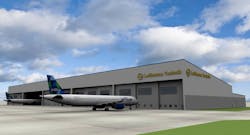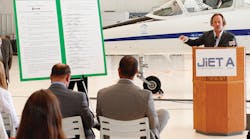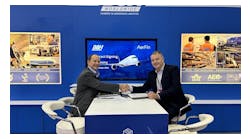Innovative growth for aviation segments was a big part of 2014 and will influence the future of the industry. Governments and economic development agencies are working together to provide company incentives to help spur local growth.
Puerto Rico will soon be the site of Lufthansa Technik and Honeywell facilities focused on MRO services and research.
And the education-industry focus of Rockford Area Economic Development Council (RAEDC) has increased the impact of aviation in Rockford, IL, with the growth of Rock Valley College and AAR.
Build it and they will come.
Puerto Rico
Puerto Rico is becoming an increasingly attractive location for the aerospace industry thanks to the efforts of Governor Alejandro Garcia Padilla and the Puerto Rico Industrial Development Company (PRIDCO). Companies such as Honeywell Aerospace, Infosys, and UTC Aerospace Services are looking at Puerto Rico (See related sidebar).
PRIDCO has been committed to attracting investment and creating jobs for Puerto Rico since 1942. As a government owned economic development organization, it offers support to companies in areas such as aerospace, life sciences, information technology, and electronics.
Puerto Rico has been chosen for aviation projects given its competitive work force, its compliance with all federal regulations related to defense activities, and the economic incentives provided for manufacturing and export services.
Puerto Rico is also assisting companies with training support through the University of Puerto Rico. “The main criteria for a company looking for a place to set up operations are the quantity and quality of skilled workers. Puerto Rico excels in that area. The university, working together with the Department of Education, has created a strategy to create the aviation mechanics school of the Department of Education at Ceiba. This school will be integrated in the efforts to develop the industry, and the university students are our main economic resource,” says García Padilla.
Lufthansa Technik
Governor Padilla, and Dr. Thomas Stueger, chief executive products, services and IT at Lufthansa Technik, turned the sod last November to mark the start of construction of the company's new overhaul facility, Lufthansa Technik Puerto Rico. Lufthansa Technik is strengthening its presence in the Americas, which are already home to Hawker Pacific Aerospace, BizJet, and Lufthansa Technik Component Services, by adding base maintenance services for Airbus A320 family aircraft.
According to estimates, the MRO world market will reach $76 billion in 2022. There are 20,000 airplanes operating today; that number will increase to 34,000 in 20 years. To keep up with demand, airlines will have to invest $4.5 trillion in new aircraft. This means a higher demand for maintenance and repair. For Latin America, the MRO market is expected to grow 4.2 percent per year, a higher rate than the global average.
"Lufthansa Technik Puerto Rico will enhance our access to the world's largest aviation market in many respects and bring us closer to both existing and potential customers. In JetBlue and Spirit Airlines we have reliable partners and customers whose airframe maintenance needs and requirements can be optimally met by Lufthansa Technik Puerto Rico," says Dr. Stueger. "The great support we experience from Governor Padilla and his administration team is much appreciated and crucial for moving our project forward."
"Puerto Rico's partnership with Lufthansa Technik represents the cornerstone of the aviation industry my administration is developing," said Governor Padilla. "Lufthansa Technik's investment elevates the Island's presence in the aerospace industry and helps create highly skilled jobs in a fast-growing sector of the world economy."
The new hangar will feature five overhaul lines across more than 215,000 square feet of space. With its state-of-the-art technologies, aircraft remain in a single line for painting following their overhauls saving time and money in the overall maintenance process.
The layout of the hangar is based on existing base maintenance operations of the Lufthansa Technik Group, where valuable know-how in the overhaul of this short-haul aircraft type is bundled; rapid turnaround times and high overhaul quality at competitive prices ensure customer satisfaction.
"We are transferring this recipe for success to our new American facility," explains Sören Stark, senior vice president Aircraft Base Maintenance Lufthansa Technik. Spirit Airlines will become Lufthansa Technik Puerto Rico's first customer in July 2015 and JetBlue will follow in November.
"Through our practical training at established overhaul sites, we ensure that Lufthansa Technik's quality proposition is fulfilled all over the world," says Elmar Lutter, CEO of Lufthansa Technik Puerto Rico.
As part of the overall incentive package, Puerto Rico is offering educational resources as well. The Aviation Maintenance Institute in Ceiba will move to Aguadilla near the new Lufthansa Technik Puerto Rico operation. The newly founded Aerospace and Aviation Institute of Puerto Rico (AAIPR) will play an important role in building up the Lufthansa Technik facility as well as other MRO operations at Rafael Hernández Airport (BQN) in Aguadilla. "With the Aviation Maintenance Institute, the University of Puerto Rico is supporting Lufthansa optimally through its offer of modular training courses and the combination of work experience and studies," explains Prof. Wilmer Arroyo, executive director of the AAIPR.
Honeywell Aerospace
First announced in April of last year, Honeywell Aerospace executives held a ground breaking ceremony in December 2014 for its new research and development laboratory. Honeywell’s investment in construction, equipment, and training is estimated in $35 million. The construction timeline and related permit process of the 73,000-square-foot facility has already been completed and construction is expected to be done by October 2015.
“This new state-of-the-art facility in Puerto Rico will enable Honeywell to expand our core competency in designing, developing, and testing a wide range of advanced aerospace avionics and electric power technologies,” says Bob Smith, vice president of engineering and chief technology officer at Honeywell Aerospace. “This move is a clear demonstration of Honeywell’s valued partnership with PRIDCO and the broader Puerto Rican community, and underscores our commitment to providing our customers with industry-leading aerospace solutions.”
“This is an exciting time for Honeywell Aerospace and our employees,” says Tim Mahoney, Honeywell Aerospace president and CEO. “Honeywell’s investment in the new lab will help us continue to design products that meet the increasingly complex needs of today’s aircraft. It is clear that Puerto Rico is becoming an important part of the aerospace industry.”
“We are thrilled with the results that the aerospace cluster strategy is driving to Puerto Rico in terms of economic development and growth,” adds Antonio Medina Comas, executive director of PRIDCO. “This announcement comes just two weeks after Lufthansa Technik and the Commonwealth formalized an agreement to establish a major MRO operation in Aguadilla.
"At PRIDCO we are proud and excited to see how important projects, that were once conceived as major economic drivers in our industrial development roadmap, begin to bear fruit,” adds Comas. “Honeywell has been one of our key partners in the efforts of growing the aerospace segment in Puerto Rico and this groundbreaking marks an important milestone in our economic diversification strategy.”
This will be Honeywell’s second Aerospace site in Puerto Rico, complementing its already successful operation in Aguadilla which was established in 2007.
Rockford
"The Rockford Region supports its long-term goals to have an comprehensive aerospace and aviation ecosystem by employing six major strategies, originally outlined by our regional industry leadership," says Carrie Zethmayr, executive director, trade & investment for the Rockford Area Economic Development Council (RAEDC). "To further define the long-term goal: a comprehensive aerospace and aviation ecosystem will offer a complete aircraft manufacturing, assembly and R&D supply-chain, led by our existing tier-one suppliers and ultimately an aircraft assembly operation. As well, the Chicago Rockford International Airport (RFD) will have a complete supply-chain of aviation services, from leading air cargo operations and logistics services in the nation by tonnage, to complete maintenance, repair and overhaul of aircraft. As well, our education institutions are aligned to achieve ramp-up of these industries, lock-step with their growth.
"We have made significant strides toward achieving this comprehensive ecosystem, most notably in recent years through Woodward’s announced expansion in 2012, and AAR’s announced development of an MRO operation at RFD in 2014. As well, the expansion of Rock Valley College’s aircraft maintenance program announced in 2014 will ensure sustainability of these programs."
The six strategies employed to achieve RAEDC's current success, and guide it toward its long-term vision are:
- Claiming the brand of the Rockford region as the future of the aerospace and aviation industries
- Growing a 21st century work force to feed innovation, and power the manufacturing
- Elevate the existing supply chain through ongoing training and development activities
- Secure business opportunities for the existing supply chain
- Attract new companies to establish operations in the market
- Foster an environment of innovation and thought-leadership
"These strategies operate in symbiosis with one another to elevate the Rockford region in the international aerospace and aviation industry," Zethmayr says, "and are fueled by the collaboration we are able to achieve between our private- and public-sector partners." Success is seen in these numbers for 2014: 2,500 jobs created or restored; 2.2 million square feet of new/expanded business space; and $295 million invested in the Rockford region.
AMT covered the efforts of Rockford Area Aerospace Network (RAAN) and Rockford Area Economic Development Council (RAEDC) in promoting the Rockford area as a mecca for aerospace companies, in Fueling Your Career with JiET-A, August 2013.
Throughout 2013, representatives from Rockford attended major aviation shows such as Ebace, Paris Air Show, MRO Americas, EAA AirVenture, and NBAA to showcase the benefits of the area. And it has provided results.
The College of Aviation at Embry-Riddle Aeronautical University’s Daytona Beach Campus partnered with Rockford Public Schools in 2013 to establish an Aerospace Institute at Jefferson High School. Embry-Riddle’s Aerospace Institute program gives high school students a collegiate model of aviation and aerospace education to introduce them to high-paying jobs in these career fields.
Embry-Riddle’s program is offered free of charge to high school students, enabling them to earn both high school credit toward graduation and college credit for courses taught by Embry-Riddle professors in their own high school classrooms. Initial courses included The Principles of Aeronautical Science course to give students a broad-based introduction to aviation history, flight theory, aircraft systems and performance, and flight physiology; and the Unmanned Aircraft Systems (UAS) course, covering the military and commercial history, growth and application of UAS. Students will be able to build and fly their own radio-controlled models.
Another new company to add a Rockford location is AAR, the largest MRO provider in North America and the third largest in the world. AAR, a $2 billion company located near Chicago, has 6,000 employees in 17 countries. The new 200,000-square-foot AAR hangar maintenance facility, which the company will lease at the Rockford airport, will be its seventh. Expected to be operational in early 2016, it is expected to operate 24 hours a day and will service wide-body aircraft, both commercial and military.
Governor Pat Quinn announced a $15 million state "investment" to build the new maintenance facility, an effort to create jobs and "drive Illinois' economy forward." The state Department of Commerce and Economic Opportunity will provide the company with $600,000 toward training costs for its new employees.
AAR says it needs the facility because it expects "healthy demand for maintenance of next-generation aircraft in North America." David Storch, AAR's CEO says, "AAR's investment in Rockford would not be possible without the economic incentives provided by the state of Illinois, which we are proud to call home."
The Greater Rockford Airport Authority (GRAA) and Rock Valley College (RVC) broke ground on the new RVC aviation maintenance technology program facility in 2014. The 40,000-square-foot building will be located on the Chicago Rockford International Airport (RFD) grounds. It will house the RVC educational course of study for aeronautical maintenance and repair.
The new facility will be four times the size of the existing program facility with six classrooms, labs, and a larger hangar. The program will have the capacity for 150 students. Graduates of the Aviation Maintenance Technology program are prepared to assume positions as airline or general aviation engine and/or airframe mechanics.
“RVC is pleased to be in partnerships with a number of businesses and public entities, including Woodward, Eclipse, and the airport,” says Mike Mastroianni, president, Rock Valley College. “These partnerships help us to provide affordable credentialing opportunities to prepare individuals to secure good jobs. This is an exciting time for the college, airport, and the entire Rockford region.”
Once complete and operational, the facility is expected to employ more than 20 employees and create new jobs for the area. Founded in 1964, Rock Valley College is a two-year community college, offering more than 100 courses for transfer, career programs, and certificates.
Build it and they will come. With the right mix of government support, training resources, and industry growth, aviation can thrive.





